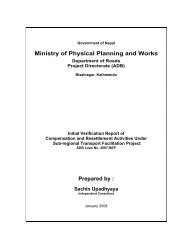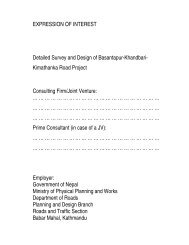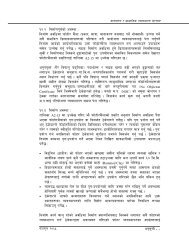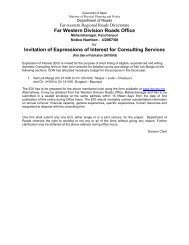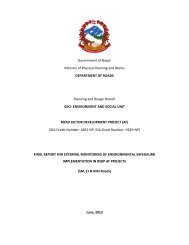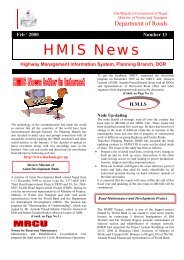Environmental & Social Management Framework - About ...
Environmental & Social Management Framework - About ...
Environmental & Social Management Framework - About ...
Create successful ePaper yourself
Turn your PDF publications into a flip-book with our unique Google optimized e-Paper software.
<strong>Environmental</strong> and <strong>Social</strong> <strong>Management</strong> <strong>Framework</strong>Chapter 11 Background and Rationale for an <strong>Environmental</strong> and<strong>Social</strong> <strong>Management</strong> <strong>Framework</strong> for the SRN Project1.1 IntroductionThis <strong>Environmental</strong> and <strong>Social</strong> <strong>Management</strong> <strong>Framework</strong> report (ESMF) isprepared for the Department of Roads (DoR) to compile in an overview andguidance manner, various safeguard and compliance aspects of environmentaland social issues related with the Sector Wide Road Program and the PriorityInvestment Plan Study for Nepal’s Strategic Road Network (SRN) planning for2007 to 2016. The Study commenced in September 2005 and was completed inDecember 2006.1.1.1 BackgroundAt present the National Road Network has altogether 15,308 km roads, including4,522 km blacktop, 3,646 km gravel and 7,140 km earth roads. Put alternatively,the National Road Network comprises 15,308 km roads including 4,977 kmstrategic roads 1,984 km urban roads and 8,347 km district roads. GoN hasproposed Strategic Road Network of about 12,600 km in the coming decade.Nepal’s economic and social development cannot be seen separately from itsgeography and accessibility. Adequate road connectivity and quality of roads aredirectly related with the country’s productive sectors such as agriculture, market,commerce, industry, and social sectors including education, health,communication, livelihood and quality of life. Good road connectivity is notablylinked with poverty alleviation. Among Nepal’s 75 district headquarters, 17 are notconnected by a motorable road, and 60 percent of the main road network andalmost all rural roads are dry-weather tracks that are not operational during therainy season. Based on the GoN policy and focus to achieve poverty alleviationalso through transportation network development, road network in Nepal hasgrown immensely over the past half century. Nevertheless, in hills, an estimated39% of the population (5 million) live at more than 4hrs walk from all weatherroads (AWR) and in the Terai, 13% (1.4 million) live at more than 2hrs walk fromthe nearest AWR. Many in these isolated communities rely on foot trails and muletracks, and have to walk to reach the nearest dry-season road. Inadequate andinefficient rural transport service therefore is a major factor constraining the useof social services and markets by communities, including education, medicalfacilities and agriculture markets. This problem is particularly acute in remoteareas and is a contributing factor to rural poverty. The strategic planning of DoRrecognizes the need for improving both strategic as well as rural transportconnectivity in the country.Road construction incurs various environmental and social impacts, includingboth beneficial as well as adverse ones. Particularly in a country like Nepal, whichhas young and fragile geology, widespread poverty in the mostly remote ruralregions, vulnerable communities, rich natural biodiversity, road construction canApril 2007 Chapter 1-1



![j:6 ]zg cfof ]hgf](https://img.yumpu.com/51286794/1/190x245/j6-zg-cfof-hgf.jpg?quality=85)

![x'nfsL /fhdfu { cfof ]hgf](https://img.yumpu.com/50581959/1/190x245/xnfsl-fhdfu-cfof-hgf.jpg?quality=85)
